Extract Dates in Excel to streamline your data analysis and ensure your timelines are meticulously managed. This technique is invaluable for project managers, financial analysts, HR professionals, and marketers alike, providing clarity and precision in time-based data management. By learning how to effectively extract dates, you can improve your planning, reporting, and decision-making processes, making your data work smarter for you. Embrace the power of Excel to transform raw data into actionable insights and keep your projects and strategies on track.
- What is retrieving dates in Excel?
- How to Subtract Dates in Excel?
- How to Calculate the End Date from the Start Date(week)?
- How to Calculate the End Date from the Start Date(month)?
- How to add or subtract days to/from today’s date?
- Some things you should know about TODAY in Excel.
1. What is Extract Dates in Excel?
To retrieve data in Excel, you need to access and display date values stored in a table.
This can be done in a variety of ways, including: For example, specify a specific cell where a date is entered, use built-in functions such as DATE, TODAY, and NOW to generate a date, or use advanced techniques such as INDEX and MATCH to specify specific conditions.
You can also get dates based on Which method is chosen depends on the specific requirements of the task at hand, such as simply displaying existing appointments, generating dynamic appointments, or retrieving appointments based on certain conditions. Excel provides a variety of tools and features to efficiently manage and retrieve data, facilitating a variety of data analysis and reporting tasks.
2. How to Subtract Dates in Excel?
Step 1: First, you need to take some dates as Date 1 and Date 2 and make a data table as shown below.
Entered the data here.

Step 2: Now, add the column from C1:C4 to get the result subtraction date there.
The column has been added here.

Step 3: Use the subtract formula as you want to. For this, the formula is: =B2-A2
Applied the formula here.

Step 4: After applying the formula, you will get the result.
The subtract result is 10, here is the result below.

Step 5: Now, use the same formula from step 3 and change the column number for subtracting the dates.
Here are the subtraction results. By subtracting a recent date (December 5, 2022) from an earlier date(December 1, 2022), you obtain the expected result of negative, as –4 as shown below.

3. How to Calculate the End Date from the start date (week)?
Step 1: First, you need to enter some dates and duration as week into an Excel spreadsheet to get an organized table of data as shown in the image.
All the data has been inputted here.
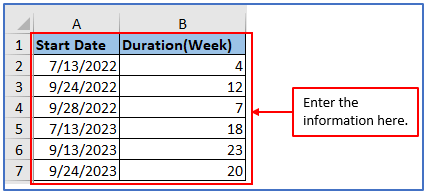
Step 2: Add the column from C1:C7 to Calculate the End Date from start date and to get the result.
Added the column here.
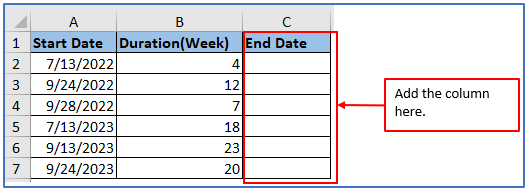
Step 3: To find out the End date, use a formula.
The formula is: =IF(A2,A2+(B2*7),””), Here A2 and B2 are the column range and 7 for week day.
Applied the formula here.
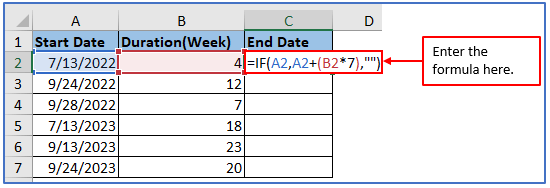
Step 4: Now press the enter button a result will come out.
The result is below.
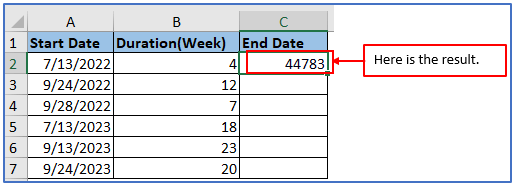
Step 5: Apply the same formula as step 3 or Drag the fill handle before the cell where you want to apply this formula.
A list of numbers will appear as shown in the following screenshot.
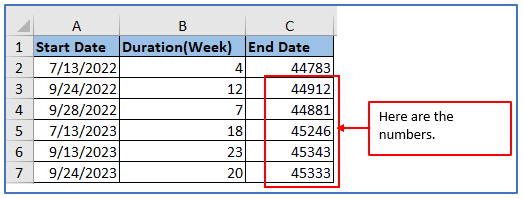
Step 6: First, select all the end date numbers to format the numbers in date format, click on the Home tab, then click on the General drop-down arrow.
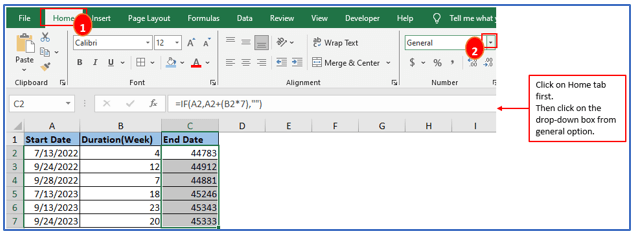
Step 7: Now, select Short Date from the General drop-down list.
Selected the short date option here.
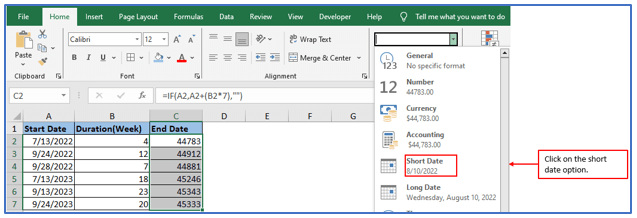
Step 8: After clicking on the short date option the numbers are formatted in date format, look at the below screenshot.
Here are the end dates.
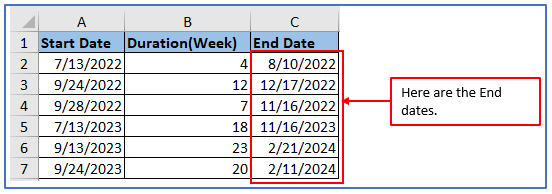
4. How to Calculate the End Date from the start date(month)?
Step 1: Take some dates and duration as month into an Excel spreadsheet to get an organized table of data as shown in the image.
All the data has been placed here.
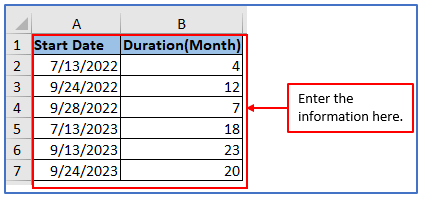
Step 2: Now, add another column in C1:C7 to get the result there.
Added another column here.
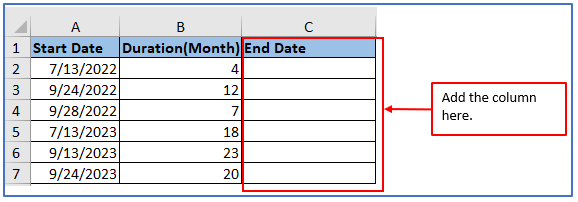
Step 3: To find out the End date use a formula.
The formula is: =DATE(YEAR(A2),MONTH(A2)+B2,DAY(A2))
Applied the formula here.

Step 4: Press Enter, you will get the output.
The end date is outlined below.

Step 5: Now, use the same formula changing with the column range or drag-down the cursor button from C2 and then you will get the result of all.
Here are the results.
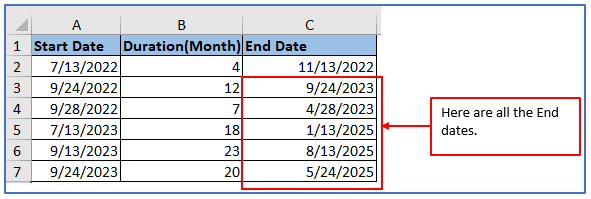
5. How do you add or subtract days to/from today’s date?
Step 1: Adding or subtracting a certain number of days from the current date can be achieved through basic addition or subtraction calculations. Take some information as arithmetic operation as shown below.
Placed the information into the table.
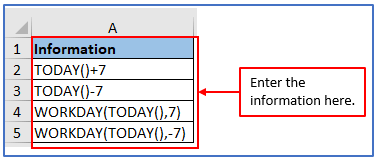
Step 2: Now, add the column in B1:B5 and C1:C5 and name it as result and description to get the output there.
The column has been added here you can see below.

Step 3: Now use the formula. The formula for A2 is: =TODAY()+7
Applied the formula here.

Step 4: After applying the formula, press enter you will get the result.
The result with description is outlined below.

Step 5: Now, use these formulas for the rest of the information.
For A3, the formula will be: =TODAY()-7
For A4, the formula will be: =WORKDAY(TODAY(),7)
For A5, the formula will be: =WORKDAY(TODAY(),-7)
Here are all the dates with the description.

6. Some things you should know about TODAY in Excel.
The function TODAY() is not fixed. This means that the function itself is continually updated every time the worksheet is opened or modified.
TODAY If the formula doesn’t update automatically, automatic recalculation may be disabled in your workbook.
To re-enable it, go to the Formulas tab > Calculation options and select Automatic.
To enter today’s date as a static, unchanging value in Excel, use the following keyboard shortcut. If you want to insert the current date and time, use the NOW function instead of TODAY.
Application of Extract Dates in Excel
- Project Timeline Analysis: Extract specific dates from a larger dataset to analyze project timelines, milestones, and deadlines, ensuring project management efficiency.
- Financial Reporting: Isolate transaction dates from financial statements to track income, expenses, and other financial events over specific periods for more accurate financial analysis.
- Inventory Restocking Schedules: Determine restocking dates by extracting dates from inventory records, aiding in efficient inventory management and planning.
- Employee Attendance Tracking: Extract dates from employee time sheets to analyze attendance patterns, leave balances, and ensure accurate payroll processing.
- Customer Relationship Management: Identify dates of customer interactions from CRM data to follow up on leads, manage customer relationships, and track sales opportunities.
- Event Planning and Management: Pull specific event dates from a larger list to manage and organize upcoming events, deadlines, and marketing campaigns effectively.
You may be interested:
